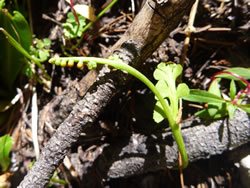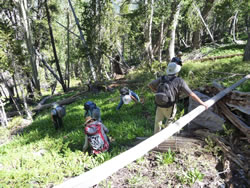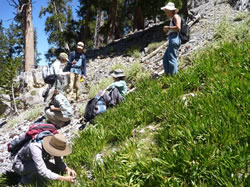Botrychium Treasure Hunts
By Jennifer Brickey Images courtesy of Cayenne Engel and Jennifer Brickey
 Botrychium crenulatum, scalloped moonwort.
Botrychium crenulatum, scalloped moonwort.
 We visited Three Springs on August 20, 2011, where five species and at least one hybrid were identified in 2002.
We visited Three Springs on August 20, 2011, where five species and at least one hybrid were identified in 2002.
On August 6 and August 20, 2011, members of the Nevada Native Plant Society visited two spring sites in the Spring Mountains, Clark County, Nevada, to search for and, hopefully, learn how to identify Botrychium species. Botrychiums, also known as moonworts, belong to the Ophioglossaceae, an ancient family of plants distantly related to modern ferns. Moonworts produce a single leaf per year that is divided in to a sterile segment, the trophophore and a fertile, spore-bearing segment, the sporophore. While size may vary, moonworts range from a few millimeters to several centimeters in height, making them difficult to find in taller spring vegetation.
Botanists have located and identified at least six species and several hybrids of moonworts in the Spring Mountains at high elevation springs. Dr. Donald Farrar, professor emeritus at Iowa State University and a leading moonwort expert, visited the Spring Mountains several times in the early 2000s to better understand the speciation of moonworts in the Spring Mountains. For our treasure hunts, we visited two springs reported by Dr. Farrar to have the highest diversity of moonworts in the Spring Mountains. We visited Mummy Spring on August 6th where three species and one hybrid were identified in 2002, and Three Springs on August 20th where five species and at least one hybrid were identified in 2002.
On August 6th, five native plant enthusiasts joined me on a hike to Mummy Spring. Our hike to Mummy Spring took roughly twice as long as it normally would take as we botanized the entire 3 miles to the spring. The trail we hiked traverses ponderosa pine, mixed conifer, and bristlecone pine forests, and we saw many Spring Mountains and southern Nevada endemics in flower. Some of the more memorable plants included Arenaria kingii rosea (also known as, Eremogone kingii glabrescens), Pedicularis semibarbata charlestonensis, Ericameria compacta, Penstemon thompsoniae jonesii, Oxytropis oreophila, Abronia nana, and Tetraneuris acaulis, to name a few. We may also have seen Opuntia charlestonensis near the trailhead.
Once we reached the spring, we searched the vegetation for about 10 minutes before we found the first moonwort. After the first, we found many moonworts within a roughly 10-meter by 10-meter area. On a follow-up trip, I counted over 150 individuals in the small area. The moonworts at Mummy Spring appear to associate closely with Dodecatheon redolens. We felt fairly confident that several of the moonworts observed were Botrychium ascendens. We may also have observed B. tunux and a hybrid of B. ascendens and B. lineare. We took a few minutes to break away from the moonworts to look at a population of Synthyris ranunculina, a Spring Mountains endemic, located directly above the spring, before members of our group had to turn around to return to town.
On August 20th, 10 native plant enthusiasts joined me on the scramble to Three Springs. Three Springs is actually a collection of more than three seeps and springs at the base of a series of cliff faces above the Las Vegas Ski and Snowboard Resort. We were able to visit six seeps during our visit. Of those six, we located moonworts at five of the seeps, all of which also had Dodecatheon redolens. Similar to Mummy Spring, moonworts occupied a very small area compared to the total area of each seep. Once we located one moonwort in a seep, though, we found many more hidden in the vegetation. We felt fairly confident that we observed B. crenulatum and B. pallidum while at Three Springs. We were less confident in our identifications of B. ascendens, B. minganense, and B. tunux. Some time in upcoming years, it would be useful to visit the remainder of the seeps and springs at Three Springs to determine how many are occupied by moonworts.
Many thanks to everyone who joined us for our Botrychium treasure hunts this summer. We succeeded in locating moonworts both days and learned a lot about the trickiness of identifying these plants to species.
References
The following is a sample of references from which one can obtain more information about moonworts, their identification, and ecology.
Anderson, D.G. (2006, May 22). Botrychium simplex E. Hitchcock (little grapefern): a technical conservation assessment (PDF). USDA Forest Service, Rocky Mountain Region.
Farrar, D. June 2006. Systematics of moonworts: Botrychium subgenus Botrychium (PDF). Department of Ecology, Evolution and Organismal Biology. Iowa State University. Ames, Iowa 50011.
Farrar, D., and S. Popovitch. 2010. Ophioglossaceae of Colorado, adjacent states, and southwest South Dakota (PDF). Native Plant Society of New Mexico Moonwort Workshop. August 11-12, 2010. Silver City, NM.
Stensvold, M.C. 2008. A taxonomic and phylogeographic study of the Botrychium lunaria complex (PDF). Ph.D. dissertation, Iowa State University, 184 pages.



